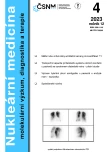Transport capacity of lymphatic system of lower extremities in patients with diabetic foot syndrome – a pilot study
Authors:
O. Lang 1,3,4; V. Prýmková 2
Authors‘ workplace:
Oddělení nukleární medicíny
1; Interní oddělení, Oblastní nemocnice Příbram
2; Klinika radiologie a nukleární medicíny, 3. LF UK a FN Královské Vinohrady Praha 10
3; Oddělení nukleární medicíny, PMCD s. r. o., Praha, ČR
4
Published in:
NuklMed 2023;12:68-71
Category:
Original Article
Overview
Introduction: Lymphatic system can play an important role in the development of some pathological processes in diabetic foot syndrome. It is associated with neurological abnormalities and various degree of peripheral vascular disease in the lower limbs which can increase the amount of interstitial fluid. We, therefore, tested function of lymphatic system of lower extremities in diabetic patients.
Material and methods: We evaluated 13 diabetic patients (4 male, 9 female, average age 64 years) with diabetic foot syndrome without skin defect. We selected control group (13 matched patients without diabetes) from our historical database. Lymphoscintigraphy was performed after subcutaneous injection of radio-colloid in the web spaces of the feet. Static images were performed immediately post injection, 30 minutes post injection at rest and after 30 minutes of walking. The transport capacity (percentage of the injected dose accumulated in the regional lymph nodes) was then calculated. Paired t-test was used for comparison.
Results: Mean transport capacity in diabetic and non-diabetic pts on the right and left side at rest and after stress was 4.4%, 18.6%, 4.8%, 19.5%, 0.4%, 4.8%, 0.3%, and 2.9%, respectively (p=0.000–0.007). Rest transport capacity in diabetics was at the level of stress transport capacity in non-diabetics while transport capacity reserve in non-diabetic pts was twice as higher as in diabetics.
Conclusion: Transport capacity of lymphatic system of both lower extremities at rest is much higher in diabetic patients comparing to patients without diabetes while their transport capacity reserve is much lower. We believe this is a sign of overload of lymphatics due to increased amount of interstitial fluid which can contribute to development of diabetic foot syndrome.
Keywords:
diabetic foot syndrome – Lymphatic system – transport capacity
Sources
- Lin CT, Ou KW, Chang SC. Diabetic Foot Ulcers Combination with Lower Limb Lymphedema Treated by Staged Charles Procedure: Case Report and Literature Review. Pak J Med Sci 2013;29(4):1062-1064. doi: http://dx.doi.org/10.12669/pjms.294.3479
- de Sire A, Inzitari MT, Moggio L et al. Effects of Intermittent Pneumatic Compression on Lower Limb Lymphedema in Patients with Type 2 Diabetes Mellitus: A Pilot Randomized Controlled Trial. Medicina 2021, 57, 1018. https://doi.org/10.3390/medicina57101018
- Blum KS, Karaman S, Proulx STet al. (2014) Chronic High-Fat Diet Impairs Collecting Lymphatic Vessel Function in Mice. PLoS ONE 9(4): e94713. doi:10.1371/journal.pone.0094713
- Bouta EM, Wood RW, Brown EB et al. In vivo quantification of lymph viscosity and pressure in lymphatic vessels and draining lymph nodes of arthritic joints in mice. J. Physiol. 2014, 592, 1213–1223
- Papatheodorou K, Banach M, Bekiari E et al. Complications of Diabetes 2017. J Diabetes Res. 2018 Mar 11;2018:3086167. doi: 10.1155/2018/3086167. PMID: 29713648; PMCID: PMC5866895.
- Kubinyi J, Knotková V, Hrbáč J et al. LYMFOSCINTIGRAFIE, provedení vyšetření a jeho interpretace. NuklMed 2018;7(S2):1-4
- Bakker K, Apelqvist J, Lipsky B et al. [International Working Group on the Diabetic Foot (IWGDF)]. The 2015 IWGDF guidance documents on prevention and management of foot problems in diabetes: development of an evidence-based global consensus. Diabetes Metab Res Rev 2016; 32(S1): S2-S6.
- Belcaro G, Laurora G, Cesarone MR et al. Microcirculation in high perfusion microangiopathy. J Cardiovasc Surg (Torino) 1995;36:393-398
- de Godoy PJM, Azoubel LM, de Godoy FMM. Intensive treatment of leg lymphedema. Indian J Dermatol. 2010 Apr-Jun;55(2):144-7. doi: 10.4103/0019-5154.62745. PMID: 20606882; PMCID: PMC2887517.
- Lang O, Prýmková V, Daňhová B. Efekt lymfodrenáže dolních končetin u pacientů se syndromem diabetické nohy – pilotní studie. NuklMed 2023;12:54–5
Obrazová dokumentace archiv autorů.
Labels
Nuclear medicine Radiodiagnostics RadiotherapyArticle was published in
Nuclear Medicine

2023 Issue 4
Most read in this issue
- Measurement of the effect of scintillation camera dead time on the quantification of 131I
- 59. Dny nukleární medicíny, Ostrava
- Importance of a hybrid lung scintigraphy in patients with emphysema – case report
- doc. MUDr. Pavel Koranda, Ph.D.
